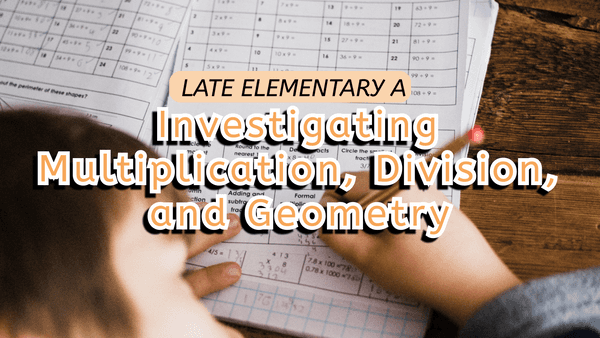Late Elementary A: Investigating Multiplication, Division, and Geometry
This is an elementary-level course designed with 4th grade standards in mind. The course advances students’ critical thinking in multi-digit multiplication and division, fractions, and geometry by applying their new skills to real-life situations.

- Private 1:1
- Format
- Age 9-11
- Learners
- Weekly
- Classes
- 50 minutes
- Per class

About this Course
Billing
Billed as
$275 / month
Scheduling
1:1 classes are 50 minutes long and can be scheduled anytime Monday-Sunday from 7am to 7pm PT. To begin, select Book your Placement Class to signup. Our team will then match you and set up your first class!
- Course duration4-6 months
- Lesson50 minutes
Learning Targets
Place Value, Rounding, Addition, and Subtraction
PVRAS-1: The student can use context clues to identify addition, subtraction, multiplication, or division problems.
PVRAS-2: The student can identify missing numbers with a placeholder.
PVRAS-3: The student can estimate and round numbers.
PVRAS-4: The student can use rounding and estimation to quickly solve a problem.
PVRAS-5: The student understands that a digit to the left has larger value than those to the right by rewriting numbers in expanded form.
PVRAS-6: The student can round large numbers to specific place values.
PVRAS-7: The student can compare large numbers using >, <, or =.
PVRAS-8: The student can add and subtract multi-digit numbers.
Multi-Digit Multiplication and Division
MDMD-1: The student can read and explain multiplication and division equations.
MDMD-2: The student can divide numbers that have a remainder, and understand what the remainder represents.
MDMD-3: The student can represent multiplication and division problems visually.
MDMD-4: The student understands multiplication is a repetitive addition problem.
MDMD-5: The student can differentiate between a prime and composite number through factoring.
MDMD-6: The student can represent large number multiplication problems visually, including rectangular arrays and area models.
MDMD-7: The student can multiply large numbers with standard practices.
MDMD-8: The student can divide large numbers with standard practices.
Lines, Angles, and Triangles
LAS-1: The student can measure angles to find their value in degrees.
LAS-2: The student can add angles to form a larger angle.
LAS-3: The student can use subtraction to find a missing angle.
LAS-4: The student can draw and identify: points, lines, rays, perpendicular, and parallel lines.
LAS-5: The student can draw and identify: right, acute, and obtuse angles.
Polygons and Quadrilaterals
PQ-1: The student can identify shapes and categorize them based on their sides and angles.
PQ-2: The student can identify whether a shape has lines of symmetry and draw those lines.
PQ-3: The student can use the hierarchy of shapes to identify attributes of shapes and their subclasses.
PQ-4: The student can identify that a class of shapes passes down their attributes to their subclasses.
Perimeter, Area and Volume
PAV-1: The student knows what a unit cube is and its attributes.
PAV-2: The student can measure volume with its appropriate units.
PAV-3: The student can mathematically solve for the volume of a rectangular prism.
PAV-4: The student can add volumes of rectangular prisms.
PAV-5: The student can identify problems that involve perimeter or area.
PAV-6: The student can calculate the area and perimeter of a rectangular shape.
PAV-7: The student can find the missing measurement of a rectangular room given the area and one measurement.
PAV-8: The student can identify problems that involve perimeter.
General Mathematical Skills
I can explain what the question is asking for.
I can explain my thinking behind my work.
I check my work carefully during or after I finish a question.
When I am stuck on a question, I show perseverance by trying a new method or asking for help.
When I am stuck on a question, I use what I know to find a place to start.
General Learning Habits
Joyful Collaboration
- I practice listening to my instructor and sharing my ideas to co-create understanding.
- I attempt tasks independently and ask my instructor questions when I need help.
Unlimited Curiosity
- I take ownership of my learning by asking meaningful questions both when I need clarification and when I want to know more about a topic.
Nimble Determination
- I practice resilience when I am frustrated that I have not yet achieved mastery of a new concept or skill; instead of complaining about challenges, I try new approaches and creative solutions.
Investment in Excellence
- I arrive to class on time and prepared to learn, with my computer set up with a strong internet connection.
- I complete my homework on time, and if I cannot complete my homework due to other obligations, I honestly communicate the reasons for late homework to my instructor.
- I do my best to stay present and on task for the whole session. I support my focus by putting away any distracting technology and setting notifications on my device to “do not disturb” mode.
Homework
Instructors will assign students roughly 60 minutes of class related problems at the end of each session. Homework is generally pulled from Juni's curriculum and is meant to complement the class experience and ensure the student continues to learn and grow outside of the session
Pre-Requisites
Completed 2nd and 3rd Grade Math
Focus for 50-minute sessions with their instructor
Who are Juni’s Instructors?
Our instructors are subject matter experts from top US universities. Instructors are highly-vetted and background checked prior to joining and undergo extensive training before ever teaching on our platform.
Upon signing up, parents are asked a series of questions that allow us to match your child with an optimal instructor based on their unique needs and interests. Factors that are considered in our matching process include Learning Style, Personality, Personal Experience, and Academic & Career Aspiration.

More Courses You Might Like
Real Reviews from Real Parents
Ray
My 3 sons ages, 10 1/2, 9 and 7 started using Juni in early June 2020 and absolutely love it. The instructors are college age kids and they relate to my boys very well. My oldest is doing both the coding and math tracks and I feel like he will be way ahead of his 5th grade class come the fall. Once the other two are old enough I will certainly be enrolling them in math as well.
Tarun Mehta
Juni has been amazing for my daughter. She is a reluctant learner when it comes to Computer Languages, but the Juni instructors have been engaging to her at a level where she feels comfortable with them and they manner in which they present the curriculum. They understood my ask that I Wanted her to start liking computer languages, and they are presenting the information in a way that is fun and relatable. I am very happy with my Juni experience and my daughter's journey with Juni so far!
Pooja
I have two boys taking classes and the Juni takes the time to match the right instructor for my children. They are patient and very consistent in their teaching. The boys are thoroughly enjoying their class and love accomplishing and learning new things!



